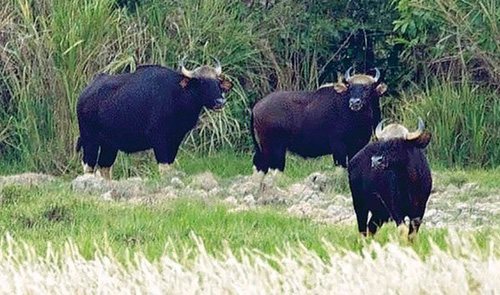Around 20 wild gayals divided into two herds are ‘locked’ in the forests of the southern province of Binh Phuoc and unable to return ‘home’ to neighboring Dong Nai Province because the forest area in between the provinces has been chopped down for the planting of rubber trees.
Previously, the forests of the two provinces were contiguous to each other on the land and only separated by the Dong Nai River starting from the Central Highlands and flowing through to sea mouths in Ho Chi Minh City.
In the past the wild animals often crossed the river to find new grass plots in different seasons but they are now separated into different herds after being ‘blocked’ by deforestation.
Plan to 'reunite' gayal couples in Dong Nai
Forest management authorities from both provinces have admitted that the Ma Da forest in Dong Nai are now more suitable for the wild animals than those in Binh Phuoc.
The Ma Da forest is part of Dong Nai Sanctuary.
So, a costly plan has been set up to rescue around 20 gayals stuck in Binh Phuoc and help them return to their previous home in Dong Nai by building a ‘green corridor’ to lead them in the right direction.
Tran Van Mui, director of the Dong Nai Sanctuary, is in charge of the plan, which is estimated to cost hundreds of thousands of U.S. dollars.
“This project is very difficult in technical terms.
“But if we delay or cancel it, the two herds of around 20 wild gayals may be killed, and then it will be a loss that nothing can compensate for,” said Mui.
Leading Tuoi Tre (Youth) newspaper journalists through forests along Ma Da, a small river that joins the Dong Nai River, Nguyen Hoang Hao – head of the forest management unit of the Dong Nai Sanctuary – said the local forests are planned to become a favorite place for the to-be-resettled gayals.
“It is easy to use anesthetic and carry them on trucks, but this should be the last resort because it would leave them shocked and make it difficult for them to integrate with the new environment,” Hao added.
Instead, the project will build a ‘green corridor’ 50 meters wide and 25 kilometers long to ‘entice’ the animals from Binh Phuoc to Dong Nai.
Plants and trees, favorite food for the gayals, will be cultivated in the corridor, which will be reinforced by barbed wires, concrete cement pillars, and an electronic fence to separate it from fruit and rubber farms in Dong Phu District of Binh Phuoc.
The fence will protect the animals from humans and gradually lead them back to Ma Da before crossing the river to return to the Dong Nai Sanctuary.
The current herds in Dong Nai and Binh Phuoc were actually living in the same herd in the past, and their previous habitat were the contiguous forests in the two provinces.
The project will also build ten big lakes in the Dong Nai Sanctuary to facilitate their survival, Hao said.
The project is supported by the forest management units of both Dong Nai and Binh Phuoc.
Money issue
The French government previously funded a €560,000 project to protect the wild gayal herds in Nam Cat Tien National Park, located in three bordering provinces of Dong Nai, Binh Phuoc, and Lam Dong – which is in the Central Highlands.
But this program ended in 2008, and the current journey to seek sponsorship from international organizations is difficult because data shows that forests in Binh Phuoc are dense and quite suitable for gayals.
In fact, most of the area is now taken up by farms, said Mui of the Dong Nai Sanctuary.
Without any forests to survive, wild gayals have taken to grazing at farms at night and face great danger from farmers.
The Dong Nai Sanctuary has proposed that Binh Phuoc contribute the funds as compensation for the forest land used as farms.
“We won’t sit and wait because the wild gayals are facing increasing threats,” Mui said.























































